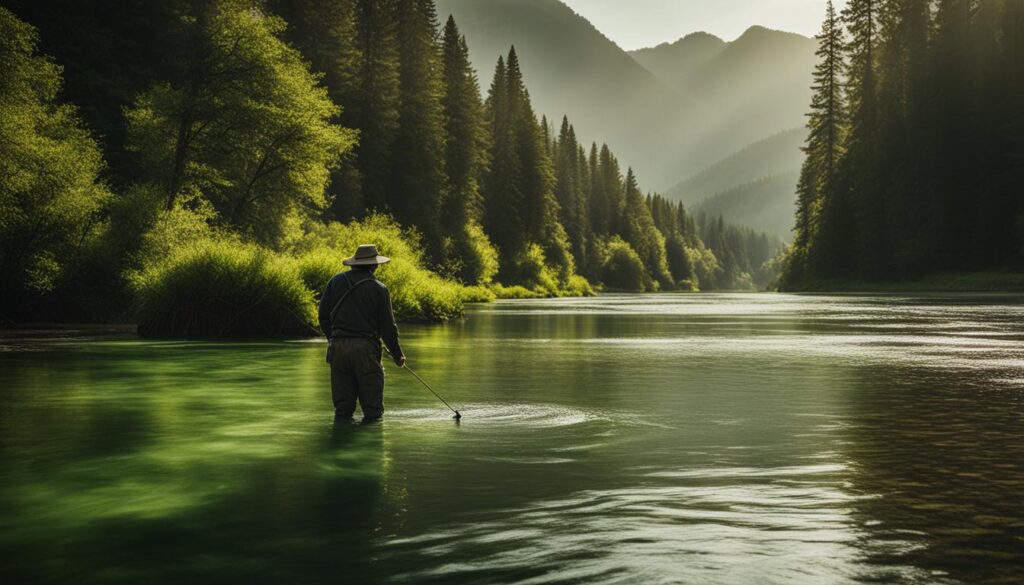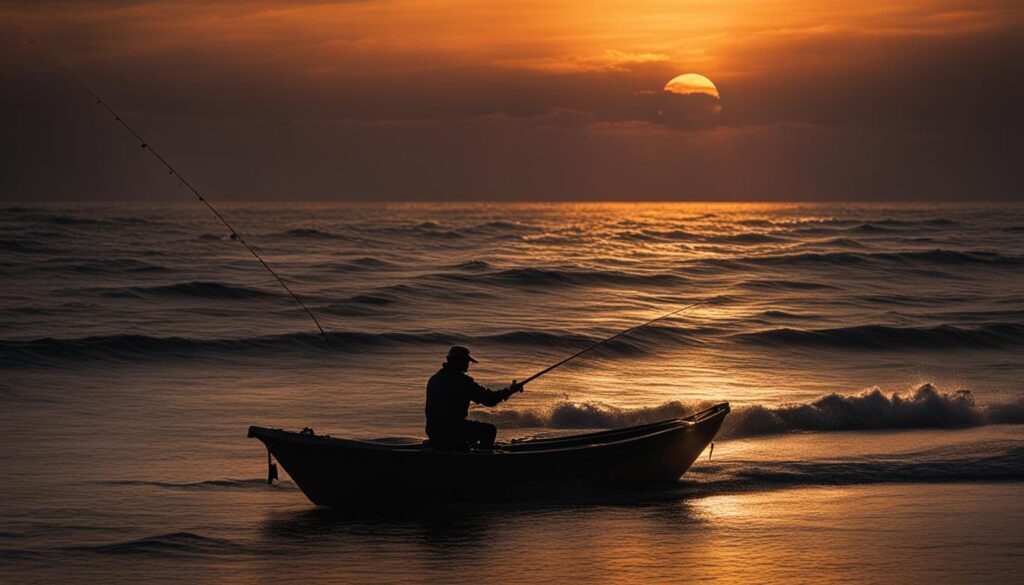We may earn money or products from the companies mentioned in this post.
Fishing is an essential industry that provides food and livelihoods for people worldwide. However, some fishing practices have a severe impact on the environment and the sustainability of fish populations. It is essential to understand these effects to promote sustainable fishing practices and preserve aquatic ecosystems.
Implementing conservation measures through effective fishery management is crucial in mitigating the impact of fishing on the environment. Sustainable fishing practices are necessary to ensure that fish stocks are not depleted and that aquatic ecosystems are not negatively affected.
Key Takeaways:
- Fishing practices can have a severe impact on the environment
- Effective fishery management is essential in mitigating the impact of fishing
- Conservation measures are necessary to preserve aquatic ecosystems
- Sustainable fishing practices promote the sustainability of fish populations
- Promoting sustainable fishing practices is crucial for the preservation of aquatic ecosystems
Minimizing Bycatch and Protecting Fish Habitats
Fishing is an essential part of our world’s economy and food supply but can also have detrimental effects on aquatic ecosystems. One of the main issues associated with fishing is bycatch, which refers to the unwanted and often unintentional catching of non-target species. Bycatch can include endangered or protected species, and the excessive amount of bycatch can have severe effects on entire aquatic ecosystems. Therefore, minimizing bycatch is an essential step towards sustainable fishing practices.
Minimizing Bycatch
Minimizing bycatch involves designing and implementing fishing gear that targets specific species while minimizing the capture of unintended species. One of the most effective methods of reducing bycatch is the use of selective gear. For example, using nets with larger openings or escape panels allows for smaller or non-target species to escape, thus reducing the amount of bycatch. Additionally, using acoustic devices that deter unwanted species from entering fishing gear can further reduce the bycatch.
Another effective strategy for reducing bycatch is the implementation of fishing quotas and other regulations to address overfishing. For example, restricting the amount of time and frequency of fishing in certain areas, or regulating the size and type of fishing gear, can help reduce bycatch and protect fish habitats.
Protecting Fish Habitats
Protecting fish habitats is essential to maintain healthy aquatic ecosystems and increase fish populations. This involves implementing fishery management practices that consider the impact of fishing on the environment and aim to minimize it. One effective method is the establishment of marine protected areas, which are designated zones where fishing is restricted or banned to allow for the recovery of fish populations and habitats.
Another strategy is the implementation of spatial management, which involves identifying areas where fishing can occur and where it should be avoided. This strategy can help protect habitats such as coral reefs and seagrass beds, which are essential for the survival and growth of many fish species.
Fishery Management
Fishery management is a critical component in minimizing bycatch and protecting fish habitats. It involves monitoring fish populations, implementing regulations to limit fishing, and establishing sustainable fishing practices. Effective management requires collaboration between fishermen, scientists, and government agencies to develop and implement policies that promote sustainable fishing practices.
Overall, minimizing bycatch and protecting fish habitats are crucial steps in promoting sustainable fishing practices and environmental conservation measures. Fishery management practices that prioritize these efforts are essential to ensure the long-term health and productivity of aquatic ecosystems.
Reducing Pollution in Fishing: A Key Role for Fishery Management
The impact of pollution in fishing can have detrimental effects on aquatic ecosystems. It is crucial to minimize pollution through responsible fishing practices to protect marine life and maintain sustainable fish populations. Fishery management plays a crucial role in reducing pollution caused by fishing activities.
Controlling Waste Disposal
In many fishing practices, waste disposal is a significant contributor to pollution in marine environments. Fishery management organizations enforce regulations to control waste disposal by implementing proper methods of waste management. These regulations involve the correct disposal of fishing gear, plastic, and other pollutants. The fishing industry has to comply with these regulations to prevent harmful pollutants from entering the environment.
Use of Eco-Friendly Materials
Fishing gear made of non-biodegradable substances, such as plastic, poses a significant threat to aquatic ecosystems. It is essential to use eco-friendly materials to reduce pollution and minimize the impact on marine life. Fishery management promotes the use of biodegradable materials, such as ropes and fishing nets. These materials break down easily and do not harm marine life.
Regulating Fuel Use
The use of fuel in fishing practices also contributes significantly to pollution in marine environments. Fishery management regulates fuel use, ensuring that vessels are equipped with the latest technologies to reduce fuel consumption. These technologies include the use of high-efficiency engines and fuel-efficient practices. They help to reduce harmful emissions, such as carbon dioxide and nitrogen oxide, which harm the marine ecosystem.
Eco-Friendly Fishing Techniques
In recent years, there has been a growing awareness of the environmental impact of fishing practices, leading to a concerted effort to find eco-friendly techniques that minimize harm to aquatic ecosystems. Sustainable fishing practices are crucial to preserving fish populations and maintaining healthy oceans and waterways. Fishery management plays a significant role in promoting and enforcing these practices.
Types of Eco-Friendly Fishing Techniques
There are several types of eco-friendly fishing techniques that reduce the environmental impact of fishing. Here are some of the most effective ones:
| Technique | Description |
|---|---|
| Pole and Line Fishing | This technique involves catching fish one at a time using a pole and baited line. It minimizes bycatch and reduces damage to the seafloor. |
| Trolling | Trolling involves fishing with a line attached to a moving boat. This technique is highly selective and minimizes bycatch. |
| Trap and Pot Fishing | This technique involves baiting traps or pots with bait and waiting for fish to enter. It is highly selective and minimizes bycatch. |
| Bottom Longlining | This technique involves using a longline with baited hooks to catch fish. It is highly selective and minimizes bycatch. |
| Harpoon Fishing | This technique involves using a harpoon to catch fish one at a time. It is highly selective and minimizes bycatch. |
Importance of Fishery Management
While eco-friendly fishing techniques are essential, they are not sufficient to preserve aquatic ecosystems. Fishery management is crucial in promoting sustainable fishing practices and ensuring that fishermen follow them. Effective fishery management involves monitoring fish populations, establishing catch limits, and implementing regulations that protect sensitive areas and species.
In conclusion, implementing eco-friendly fishing techniques and effective fishery management practices is essential to safeguarding our aquatic ecosystems and ensuring the sustainability of fish populations. As consumers, we can also play our part by choosing sustainable seafood options and supporting fisheries that follow sustainable practices.
Sustainable Seafood Consumption
Sustainable seafood consumption is an essential component of preserving our aquatic ecosystems. By supporting fisheries that follow sustainable practices, we can help maintain fish populations’ health and ensure their long-term survival.
Fishery management plays a crucial role in promoting sustainable seafood consumption. Through effective management practices, fishing efforts can be controlled to prevent overfishing and protect vulnerable species.
The Benefits of Sustainable Seafood Consumption
Consuming sustainable seafood not only helps protect the environment but also provides health benefits. Sustainable seafood is typically of higher quality and contains fewer harmful contaminants than conventionally harvested fish.
Furthermore, by choosing seafood from sustainable sources, we can support the fishing industry’s economic viability. This, in turn, helps support coastal communities and provides jobs for many people.
How to Choose Sustainable Seafood
Choosing sustainable seafood can be easy with a little knowledge. There are several tools and resources available to help consumers identify seafood that has been sustainably sourced.
- Look for seafood products with eco-labels such as the Marine Stewardship Council (MSC) or the Aquaculture Stewardship Council (ASC).
- Research the seafood you plan to purchase and learn about its sustainability status.
- Support local fishing communities and farmers who use sustainable practices.
The Role of Fishery Management
Fishery management is critical to ensuring sustainable seafood consumption. By setting quotas and regulating fishing practices, management practices can help prevent overfishing and protect vulnerable species.
Through partnerships with government agencies and fishing industry stakeholders, fishery management practices can ensure sustainable fishing practices are maintained, and conservation measures are implemented.
Fishing Industry Regulations and the Role of Fishery Management
The fishing industry is a crucial sector that provides food and livelihoods for millions of people around the world. However, unregulated fishing practices can lead to overfishing, habitat destruction, and other environmental problems. Therefore, governments and international organizations have implemented fishing industry regulations to ensure sustainable practices and protect our aquatic ecosystems.
Government Regulations
Government agencies are responsible for enforcing fishing industry regulations, which differ from one country to another. Some regulations include:
| Regulation | Description |
|---|---|
| Fishing quotas | Limiting the amount of fish that can be caught |
| Minimum size limits | Requiring fishermen to throw back undersized fish to allow them to mature and reproduce |
| Fishing gear restrictions | Limiting or banning the use of certain fishing gear that can harm non-target species or habitats |
International Regulations
International organizations such as the United Nations’ Food and Agriculture Organization (FAO) and the International Maritime Organization (IMO) also play a vital role in regulating the fishing industry on a global scale. The FAO has developed a Code of Conduct for Responsible Fisheries that provides guidelines for sustainable fishing practices. The IMO has implemented regulations to prevent ship pollution and mitigate the impact of fishing vessels on the environment.
The Role of Fishery Management
Fishery management is a crucial component in enforcing fishing industry regulations and ensuring sustainable practices. It involves regulating fishing activities, conserving habitats, and managing fish populations to maintain healthy ecosystems. Effective fishery management relies on scientific research, policy development, and stakeholder engagement to balance environmental, economic, and social objectives. It also requires monitoring and enforcing compliance with regulations to prevent overfishing, habitat degradation, and pollution caused by fishing activities.
In conclusion, fishing industry regulations and fishery management play a crucial role in mitigating the environmental impact of fishing. They ensure sustainable practices that maintain healthy ecosystems, preserve fishery resources, and provide food and livelihoods for present and future generations.
Conservation Measures and Their Impact
Fishing activities have a significant impact on aquatic ecosystems, which has led to the implementation of various conservation measures to mitigate the environmental impact of fishing practices. These measures are primarily focused on promoting sustainable fishing practices and effective fishery management strategies.
The Role of Fishery Management
Fishery management plays a crucial role in promoting sustainable fishing practices and minimizing the impact of fishing on aquatic ecosystems. Effective fishery management involves careful monitoring of fish populations, assessing fishing practices, and implementing regulations to ensure that fishing does not exceed the capacity of the ecosystem to replenish fish stocks.
By enforcing responsible fishing practices and implementing measures to reduce bycatch and pollution, fishery management can mitigate the impact of fishing activities on the environment. Furthermore, by establishing marine protected areas and promoting ecosystem-based management practices, fishery management can help preserve the health of aquatic ecosystems and the sustainability of fish stocks.
Conservation and Protection Measures
Several conservation measures have been implemented to address the environmental impact of fishing. Below are some of the most significant conservation measures:
| Conservation Measure | Impact |
|---|---|
| Marine Protected Areas (MPAs) | MPAs protect key marine habitats and biodiversity, allowing fish stocks to recover and providing a refuge for species impacted by fishing. |
| Quotas and Fishing Limits | Setting quotas and fishing limits ensures that fishing does not exceed the capacity of the ecosystem to replenish fish stocks, preserving the sustainability of fish populations. |
| Regulations on Gear and Methods | By regulating the gear and methods used in fishing, conservation measures can minimize bycatch and reduce damage to marine habitats. |
These conservation measures have had a significant impact on mitigating the environmental impact of fishing practices. However, their effectiveness depends on their enforcement and implementation, as well as the cooperation of fishing communities.
The Importance of Community Involvement
Conservation measures can only be fully effective when fishing communities are involved in their implementation and enforcement. Successful conservation measures require the cooperation of fishing communities to ensure that they are adhered to by all fishers.
Furthermore, involving fishing communities in the conservation process can not only promote sustainable fishing practices but also provide economic benefits by ensuring the long-term health of fish stocks and the viability of fishing industries.
Overall, conservation measures are essential in mitigating the environmental impact of fishing practices. Through effective fishery management and the implementation of sustainable fishing practices, we can preserve the health of aquatic ecosystems and ensure the sustainability of fish stocks for future generations.
Conclusion
Understanding the environmental impact of fishing practices is crucial in maintaining healthy aquatic ecosystems and preserving fishery resources. It is crucial to implement sustainable fishing practices and conservation measures through effective fishery management to minimize the Fishing and Environmental Impact.
Minimizing bycatch and protecting fish habitats are some of the strategies that can be employed to safeguard our aquatic ecosystems. Reducing pollution through responsible fishing practices and adopting eco-friendly fishing techniques can also play a crucial role in mitigating the environmental impact of fishing.
Consumers can also make informed choices and support sustainable seafood consumption practices to promote responsible fishing practices. Governments and international organizations play a pivotal role in regulating the fishing industry and enforcing policies to safeguard the environment and maintain fishery resources.
It is important to continue implementing sustainable fishing practices and conservation measures to protect our aquatic ecosystems and preserve fishery resources for future generations.
FAQ
What is the environmental impact of fishing practices?
Fishing practices can have various environmental impacts, including overfishing, habitat destruction, bycatch of non-target species, and pollution. Understanding these impacts is crucial in implementing sustainable fishing practices and conservation measures.
How can bycatch be minimized?
Bycatch, the unintentional catching of non-target species, can be minimized through the use of selective fishing gear, such as modified nets or hooks, and employing techniques that reduce interactions with non-target species. Strict fishery management regulations also play a significant role in minimizing bycatch.
Why is protecting fish habitats important?
Protecting fish habitats is essential for maintaining healthy ecosystems and sustaining fish populations. Fish habitats provide shelter, breeding grounds, and feeding areas for various species. By protecting these habitats, we can ensure the long-term viability of fish populations and the overall health of aquatic ecosystems.
How can pollution in fishing be reduced?
Pollution in fishing can be reduced through responsible fishing practices, such as minimizing fuel spills, properly disposing of fishing gear and waste, and using eco-friendly fishing techniques. Effective fishery management is crucial in implementing pollution reduction measures and enforcing regulations to prevent pollution from fishing activities.
What are eco-friendly fishing techniques?
Eco-friendly fishing techniques are practices that minimize the environmental impact of fishing. These may include using sustainable fishing gear, reducing bycatch, promoting selective fishing methods, and implementing fishery management measures that prioritize resource conservation and ecosystem protection.
Why is sustainable seafood consumption important?
Sustainable seafood consumption is vital for preserving aquatic ecosystems and maintaining fish populations. By making informed choices and supporting fisheries that follow sustainable practices, consumers can contribute to the long-term health and sustainability of marine resources.
What regulations govern the fishing industry?
The fishing industry is regulated by various governmental agencies and international organizations. These regulations aim to ensure sustainable fishing practices, protect fishery resources, and minimize the environmental impact of fishing. They may include restrictions on fishing seasons, catch limits, gear specifications, and licensing requirements.
What impact do conservation measures have on fishing practices?
Conservation measures play a crucial role in mitigating the environmental impact of fishing practices. They help preserve fish populations, protect sensitive habitats, and maintain the overall health of aquatic ecosystems. Effective implementation of these measures requires collaboration among stakeholders, including fishermen, scientists, policymakers, and conservation organizations.
Affiliate Disclosure: This post may contain affiliate links. If you purchase through our link, we may receive a small commission, but at no additional cost to you. For more information, please see our Disclosure statement.



